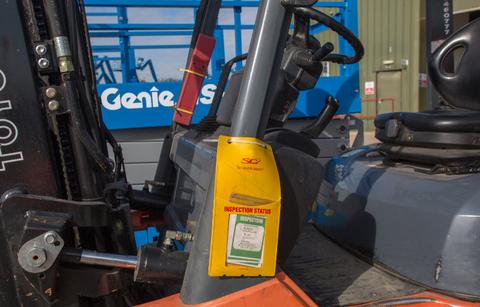
It's worth noting that although a pre-use inspection is often called a daily inspection, in some situations it might not be enough, for example, if a warehouse operation is 24x7 and the forklift is also used in the same frequency.
The pre-use or daily check only takes a few minutes, but it can help you operate safely and efficiently, identifying any faults or showing early signs of wear in common areas.
Typical fork lift truck check should include the following areas:
- Damage to tyres, e.g. example swarf, nails and other embedded material, cuts and bubbles. Pay particular attention to the side walls.
- Pressure of pneumatic tyres.
- Condition of the wheels, particularly the flanges on rims fitted with pneumatic tyres.
- Tightness and security of wheel nuts.
- Functional test of the parking brake, service brakes and steering gear to ensure they are working efficiently.
- Check fluid levels, e.g. fuel, water, engine and transmission oils.
- Check that batteries are adequately charged and leak free, the charger is switched off, the charge lead disconnected and properly stored, and the battery retention device is in place.
- Functional test of systems for lifting, tilting and manipulation, including attachments to ensure they are working properly.
- Visual inspection of hydraulic systems to check for obvious leaks, ensure hydraulic fluid levels are correct when the forks are in the parked position.
- Condition and security of the overhead guard and load back-rest extension.
- Check forks, for cracks, particularly on the heels and mounting hooks, bent or damaged fork tips and missing or damaged fork positioning locks.
- Check chains, for secure anchor pins, fixing bolts, damaged or elongated links and lubrication.
- Functional test warning signal, e.g. horn; lights, beacons.
- Check mirrors and any other visibility aids, if fitted.
Where's a good place to start?
It’s recommended that pre-use checks are carried out in a safe area away from passing vehicles and pedestrians. A good way to approach it is to start with the visual checks ie: forks, mast, lift chain, lights, mirrors, wheels and tyres, hydraulics and the operator's compartment, working in a methodical way, walking around the truck. The next step is to check all operational components are working as expected such as fork movement, fuel source, brakes, steering and seatbelt.
Lastly, you should keep a record and report any faults or defects, a reliable and documented system of daily or pre-shift checks is the cornerstone of forklift safety and good preventative maintenance.